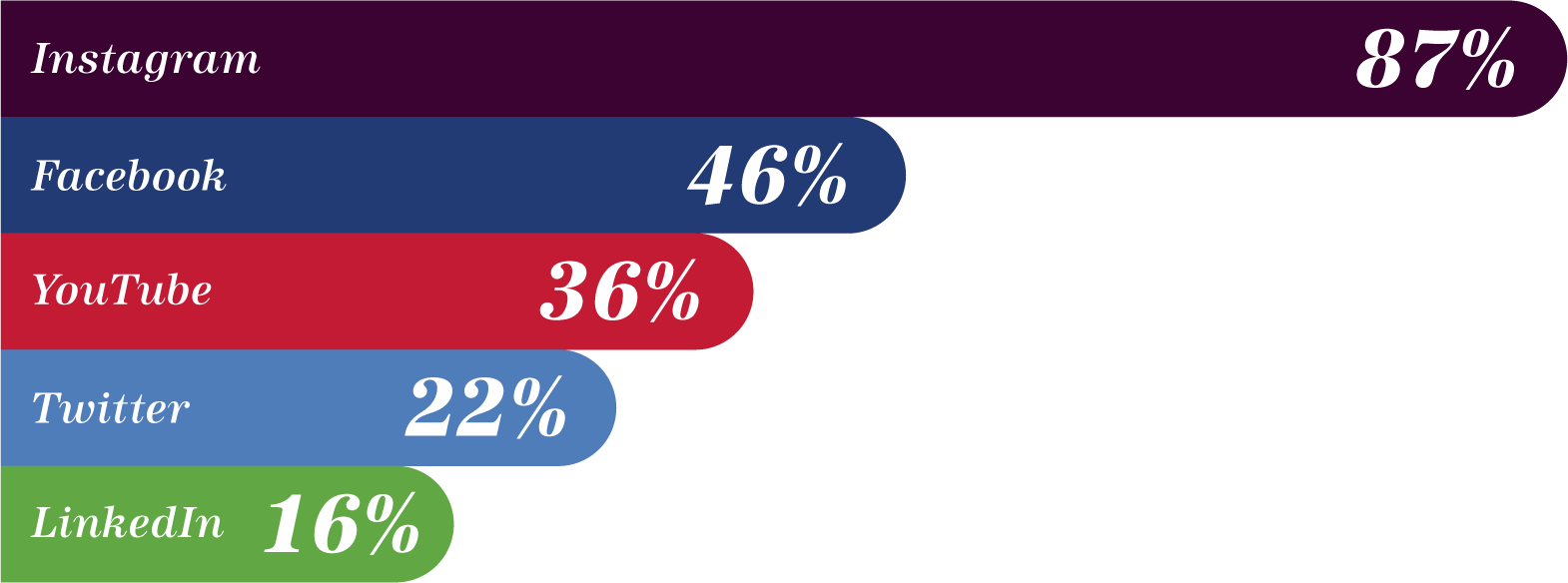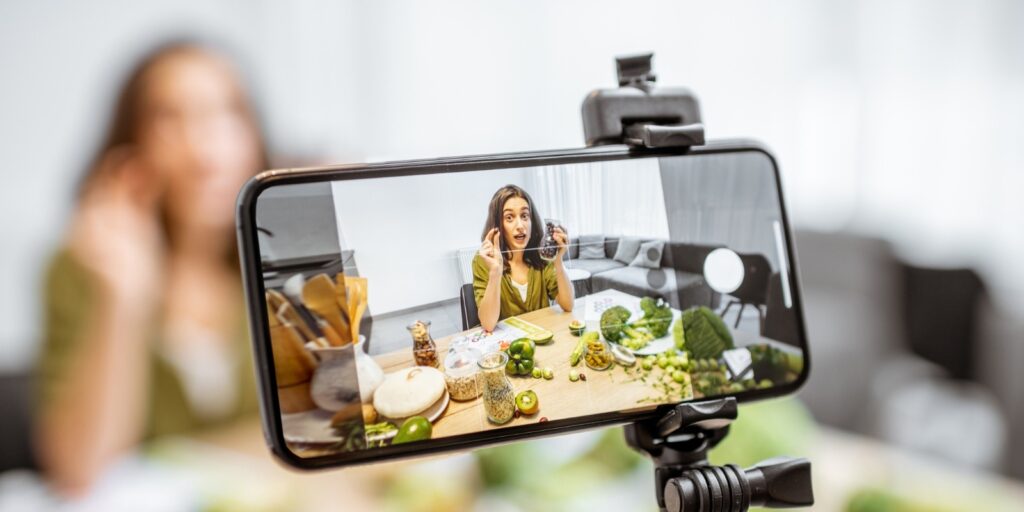Influencer marketing as a marketing vertical is still shrouded in a bit of mystery and as a result, often our conversations with clients garner a lot of questions! Are you questioning influencer marketing? Worry not. We’ve compiled our FAQs about this topic and our answers to help you get ahead of the curve.
Answers to FAQs Our Clients Ask Most About Influencer Marketing
1. What is influencer marketing?
Think of influencer marketing as having a brand spokesperson, except instead of a TV advertisement, your content is primarily featured on social media platforms. Additionally, influencers typically create their own content with their audiences in mind. Influencer marketing leverages influencers to promote a brand’s message through authentic content. Influencers have influence over potential buyers (their audience) and can work with brands to create content highlighting products and share it organically in their content.
2. How do you find influencer partners?
Much more goes into picking the right influencers than simply finding people who have high reach or followers. It takes time, dedication and research to identify the influencers that are worth the effort of building meaningful relationships. Remember, the type of influencers you want to reach have credibility within their communities. Make sure they align with your brand and values, and vice versa! Searching for influencers can feel never-ending, so we have some bullet points to try and hone in your search time.
Define your criteria:
- Similar values – This speaks for itself, but if you’re a family-friendly brand, look for a family-friendly influencer – rule out any with off putting language or opinions.
- Browse for direct competitors and/or brands that don’t align with yours – if the influencer’s last paid sponsorship was for a popular processed food brand, it may not look genuine or authentic for the next post to be about fresh produce.
- Their demographics and how they align with your target audience – If you’re looking to reach more of a male audience, take a look at the influencer’s followers or engagements to see which influencer is right for you.
3. Which networks are the best for them to share?
When thinking through desired outcomes, the social media platform the influencer relies on will play a heavy role. According to the study by “Influencer Marketing Hub,” Instagram ranks #1 for the most important and impactful channel. 87% survey respondents consider Instagram the most important for their campaigns. Followed by only 46% claiming that Facebook was important.
For us, the hierarchy by which we judge our influencers based on platform is Instagram and then Pinterest. Generally, influencer marketing is less common on Facebook and Twitter. But if they have and thriving Facebook and/or Twitter presence, that’s a bonus!
You’ll notice Pinterest missing here but this information is based on data across all industries. For fresh produce, we believe that Pinterest is a crucial platform to leverage. 90% of Pinterest users use the platform to make purchasing decisions AND 77% of Pinterest users have discovered a new brand/product on the platform. This means that Pinterest audiences are on the lookout for new brands and ideas!
To note, while Instagram is the top sought after platform, it is also where you’re going to see your most expensive cost/impression or engagement.
Social Platforms for Influencer Content

Source: Influencer Marketing Hub
4. Do influencers drive sales?
Yes. No. Sometimes. Not every brand turns to influencers to help drive sales.
Oftentimes, the primary goal when working with an influencer is to drive brand awareness. Brand awareness can be garnered through social posts featuring product placements or even recipe content created and shared on their blogs. Another common goal for influencers is to help grow a brand’s social media following through post as and/or co-sponsored giveaways.
We’ve worked with influencers to help our clients promote their ecommerce sites. In fact, Dora’s Table helped Winter Sweetz promote their boxed grapefruit during their most recent 2020/2021 season. And Style at a Certain Age promoted Natural Delight’s NEW chocolate covered dates – available on Amazon. In fact, the day that this influencer shared her content about the product, Natural Delights sold out!
5. What are the benefits of influencer marketing?
Influencer marketing is all about relationship building. It builds relationships between brands and influencers AND brands with the influencers’ audiences.
Additionally, influencer marketing builds trust with your potential customers, because people are more likely to trust you and buy from you if the message about your brand is being told to them from someone they trust, like a friend or an influencer. Influencer marketing is word of mouth marketing on steroids.
We use influencers to help create exciting content which helps our brand develop a diverse content marketing strategy. AND it improves your brand awareness and affinity with the RIGHT people.
6. How much do I need to spend on influencer marketing?
This is probably the biggest burning question you had when you clicked on this post, so here we go!
There are two ways we assess content creation with influencers: with and without recipe development. Without recipe development means it’s more of a product placement post, typically without product incorporation or suggested usage.
It’s a common misperception that influencer marketing requires a big budget. On average, we work with influencers who do full recipe development posts for anywhere from $200 to $1,600 – it completely depends on what their follower count is (specifically on Instagram). A $200 influencer likely has a few thousand followers, whereas the $1,600 per post influencer has 20k+ followers. Remember, recipe development is a skill and influencers use their knowledge about consumer trends and data to create something special for your brand. This often includes recipe testing, multiple photos taken throughout the creation process, etc.
If you’re looking purely for product placement, then you can find influencers with a lower cost per follower that would be happy to pose with or style the product in a charming way.
7. What size following should they have?
The spectrum is wide: micro-influencer to celebrity. Which is the best route to go? The answer is simple: it depends.
There are a variety of factors that impact who you should work with, size-wise. We typically recommend brands start by partnering with influencers with a following around 4k followers. Ultimately, it depends on what your goals are.
In short, if your goal is to build brand awareness, the larger the following the better. If you’d like to work with an influencer to simply create content for you to share, then maybe reach isn’t as important as the quality of their content. Unfortunately, like most things in life there isn’t a secret formula to determine which influencers are going to covert more followers, website visits or sales, so start small and get comfortable with testing partners.
What questions didn’t we cover? Shoot us a note at info@dma-solutions.com and we’ll be sure to address those in a follow-up post! Better yet, we’d love to hop on a call to discuss how influencer marketing can elevate your brand.
{{cta(‘2ad16cba-fe1e-4622-a1f8-403bc3eb0359′,’justifycenter’)}}












